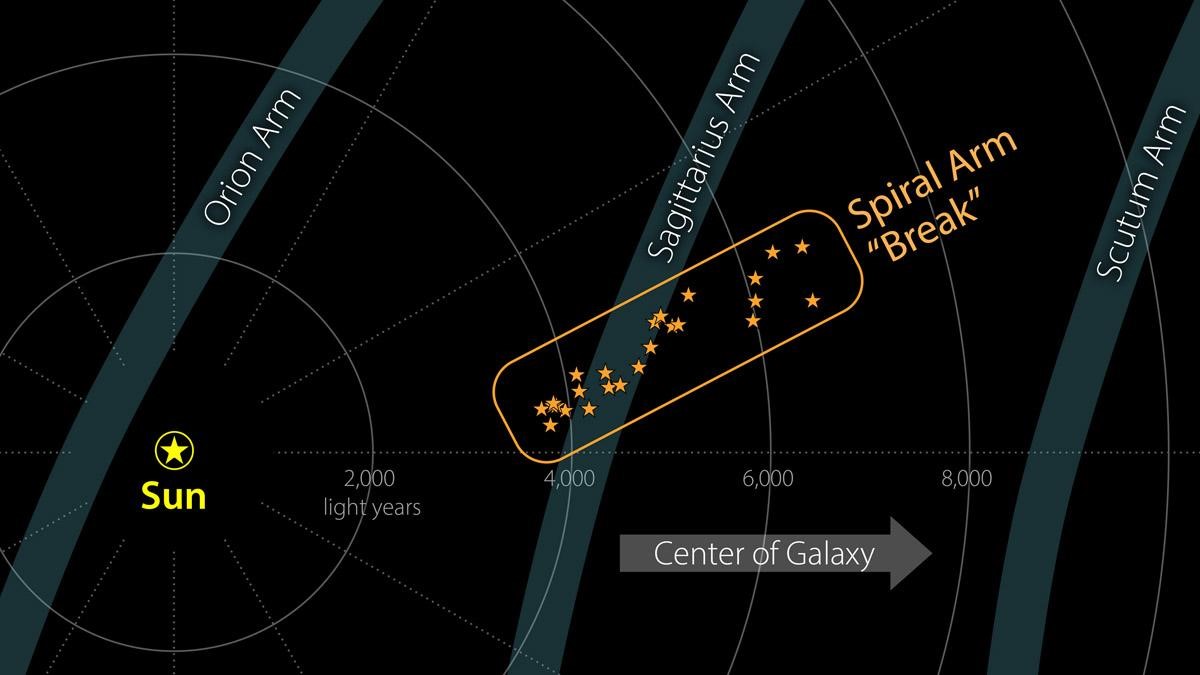A break in the Milky Way’s Spiral Arms was hidden in plain sight
The newly discovered feature offers insight into the large-scale structure of our galaxy, which is difficult to study from Earth’s position inside it.
As reported in a new study carried out by scientists from the Cosmostatistics Initiative (COIN), lead by Rafael S. de Souza, an Associate Professor at Shanghai Astronomical Observatory, astronomers have spotted a previously unrecognized feature of our Milky Way galaxy: A contingent of young stars and star-forming gas clouds is sticking out of one of the Milky Way’s spiral arms like a splinter poking out from a plank of wood. Stretching some 3,000 light-years, this is the first major structure identified with an orientation so dramatically different than the arms.
“The true face of Lushan is lost to my sight, for it is right in this mountain that I reside."
Similarly, astronomers can’t see the full structure of our home galaxy because Earth is inside it.
Astronomers have a rough idea of the size and shape of the Milky Way’s arms, but much remains unknown. Even though we can’t see the Milky Way’s full structure, the ability to measure the motion of individual stars is useful for understanding this phenomenon. To learn more, scientists from the COIN carried on data-intensive studies, focusing on a nearby portion of one of the galaxy’s arms, called the Sagittarius Arm.
The composition of the new feature is revealed
Young stars and nebulae are thought to align closely with the shape of the arms they reside in. To get a 3D view of the arm segment, the scientists used the latest data release from the ESA (European Space Agency) Gaia mission to measure the precise distances to the stars.
“Distances are among the most difficult things to measure in astronomy,” said Alberto Krone-Martins, an astrophysicist and lecturer in informatics at the University of California, Irvine and a member of the Gaia Data Processing and Analysis Consortium (DPAC). “It is only the recent, direct distance measurements from Gaia that make the geometry of this new structure so apparent.”
As revealed from the combined data analysis, the stars in the newly discovered structure likely formed around the same time, in the same general area, and are uniquely influenced by the forces acting within the galaxy, including gravity and shear due to the galaxy’s rotation.

A new structure has been found in the Milky Way: An elongated feature that sticks out from the thin Sagittarius spiral arm at an abrupt angle and which contains many famous objects like Eagle, Omega, Trifid, and Lagoon Nebulae. Credit: NASA/JPL-Caltech
It brings a new look at the view of the tightness of the MW’s arm
In the new study, researchers also relied on another COIN project, the SPICY catalog of more than a hundred thousand newborn stars discovered by Spitzer.
“A key property of spiral arms is how tightly they wind around a galaxy,” said Michael Kuhn, an astrophysicist at Caltech. This characteristic is measured by the arm’s pitch angle. A circle has a pitch angle of 0 degrees, and as the spiral becomes more open, the pitch angle increases. “Most models of the Milky Way suggest that the Sagittarius Arm forms a spiral that has a pitch angle of about 12 degrees, but the structure we examined really stands out at an angle of nearly 60 degrees.”
Similar structures – sometimes called spurs or feathers – are commonly found jutting off the arms of other spiral galaxies. For decades scientists have wondered whether our Milky Way’s spiral arms are also dotted with these structures or if they are relatively smooth. The discovery of the new feature provides the first strong evidence of these structures in our own galaxy.
“Ultimately, this is a reminder that there are many uncertainties about the large-scale structure of the Milky Way, and we need to look at the details if we want to understand that bigger picture,” said Robert Benjamin, an astrophysicist at the University of Wisconsin-Whitewater and a principal investigator on the GLIMPSE survey. “This structure is a small piece of the Milky Way, but it could tell us something significant about the Galaxy as a whole.”
“These data-intensive studies were enabled by combining skills from researchers from different fields and academic backgrounds, each providing a unique perspective on astronomical data analysis. This is one of the goals of COIN.” Said Rafael S. de Souza, chair of COIN.
COIN is a worldwide endeavor aimed to create an interdisciplinary community around data-driven problems in Astronomy. The wide-range applications of their methods include, but are not limited to the use of Active Learning for Supernova Cosmology, detection of cosmic voids, and the discovery of the Gaia-COIN Open clusters (OCs), an increment of at least 20% of the previously known OC population up to 1.8 kpc.
COIN is an example of how interdisciplinarity and diversity can contribute to transforming data into scientific discoveries, and other exciting results are yet to come.
Link to the scientific work:
https://www.aanda.org/articles/aa/full_html/2021/07/aa41198-21/aa41198-21.html
Science Contacts:
Rafael S de Souza, Shanghai Astronomical Observatory, CAS, drsouza@shao.ac.cn
READ MORE: Astronomers Find a ‘Break’ in One of the Milky Way’s Spiral Arms
More About the Mission and collaboration
The Cosmostatistics Initiative (COIN) is an international network whose goal is to foster interdisciplinarity inspired by Astronomy.
For more information about COIN:
COIN address: https://cosmostatistics-initiative.org/
Twitter: @iaa_coin
The Gaia spacecraft operations team works from the European Space Operations Centre (ESOC) in Germany, while the science operations are performed at the European Space Astronomy Centre (ESAC) in Spain. A consortium of more than 400 scientists and engineers is responsible for the processing of the data.
More information on the Gaia Data Releases can be found here:
https://www.cosmos.esa.int/web/gaia/release.
For more information about NASA’s Spitzer mission, go to:
https://www.jpl.nasa.gov/missions/spitzer-space-telescope
https://www.ipac.caltech.edu/project/spitzer
Download attachments: